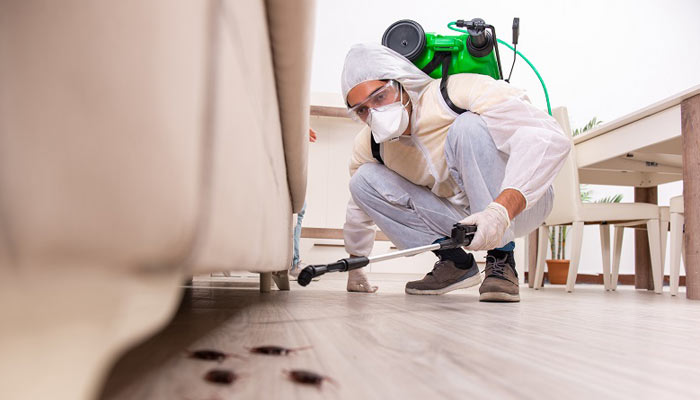Understanding the Art of Parasite Control: Proven Approaches for Long-Term Avoidance and Eradication
Insect problems can be a relentless challenge for home owners and companies alike, needing a tactical strategy to effectively handle and remove these unwanted trespassers. By understanding the art of pest control with tried and tested strategies for long-lasting avoidance and eradication, one can establish a positive protection against potential hazards. Understanding the habits of parasites, implementing integrated insect monitoring techniques, and using all-natural remedies are simply a few crucial components necessary to attaining long-term success in this undertaking. However, the complexities of preserving tidiness, performing normal inspections, and thorough surveillance play equally important duties in maintaining a pest-free setting. As the battle versus insects remains to develop, taking on a comprehensive technique becomes vital in safeguarding your property from prospective injury.
Comprehending Bug Actions
To successfully apply parasite control strategies, it is important to comprehend the intricate behaviors displayed by different insects in different environments. Comprehending insect behavior is a basic element of developing reliable insect management strategies. Each pest varieties has one-of-a-kind habits and choices that affect their reproduction, activity, and feeding patterns. By examining these habits, bug control specialists can identify the most susceptible factors in the bug's life process to target treatments extra efficiently.
As an example, rats like rats and computer mice are nighttime creatures that favor dark, secluded spaces near to a food resource. a1 portland pest control bed bugs. Recognizing this, insect control specialists can concentrate on sealing access points and removing food attractants to hinder these parasites. In comparison, pests such as cockroaches thrive in cozy, damp areas with accessibility to water. By resolving wetness issues and securing fractures and crevices, infestations can be considerably decreased.
Carrying Out Integrated Parasite Administration
Implementing Integrated Parasite Management involves making use of an alternative method to resolve bug issues by integrating various control techniques and techniques. This approach highlights prevention, monitoring, and control of bugs through a mix of biological, cultural, physical, and chemical treatments. By integrating numerous strategies, Integrated Parasite Administration (IPM) aims to decrease making use of pesticides while efficiently handling pest populaces.
One secret aspect of IPM is recognizing the specific parasite issue and recognizing its behavior and life cycle. This understanding helps in establishing the most suitable control actions to apply. Avoidance is likewise a fundamental concept of IPM, concentrating on getting rid of factors that attract parasites, such as water, food, and shelter. Normal tracking and inspection are important to find bug invasions early and stop them from rising.
Furthermore, IPM advertises using eco-friendly and lasting pest control methods to minimize injury to non-target microorganisms and the surrounding environment - a1 pest control portland bed bugs. By taking on an Integrated Parasite Administration technique, people and businesses can effectively take care of insects while reducing dependence on chemical pesticides
Using Natural Remedies
Structure upon the foundation of Integrated Pest Monitoring, a shift in the direction of using this page natural remedies supplies an environmentally friendly method to pest control. All-natural treatments harness the power of nature to deter and remove bugs without using severe chemicals that can damage the setting, people, and helpful organisms.

Additionally, planting pest-repelling plants like marigolds, lavender, and mint around gardens and homes can help deter parasites normally. browse around this site These plants produce odors that insects locate undesirable, driving them away without the demand for chemical treatment.
Keeping Tidiness and Health

Carrying out a routine cleansing schedule and ensuring all members of the household or staff members are informed on correct health techniques can go a lengthy method in parasite avoidance. By preserving sanitation and hygiene standards, the atmosphere becomes less hospitable to bugs, ultimately sustaining long-lasting insect control initiatives.
Routine Examinations and Tracking
Normal examinations and keeping an eye on play a critical role in proactively determining and resolving potential insect concerns before they intensify. By carrying out normal examinations of both the interior and outside of a residential property, parasite control experts can detect very early indications of infestations, bug entry points, and conditions for bug activity. Tracking entails making use of catches, lures, and various other tools to track insect activity degrees and varieties present on the properties. This data is very useful for determining the most effective treatment approaches and assessing the success of insect control techniques in time.
Consistent surveillance permits the very early detection of bug troubles, allowing speedy intervention to stop widespread invasions that can be pricey and challenging to eradicate. Additionally, normal evaluations and monitoring assistance to adhere to governing requirements and preserve a secure, pest-free environment for residents. Applying a proactive technique via routine evaluations and surveillance is a cornerstone of efficient parasite management, giving satisfaction and lasting protection against pest hazards.
Conclusion
Finally, grasping the art of parasite control includes understanding parasite actions, carrying out incorporated pest administration, utilizing natural solutions, maintaining cleanliness and health, and conducting regular examinations paste control chemicals and monitoring. By following these tested strategies for long-term prevention and elimination, people can properly take care of pest infestations and create a healthier and much safer atmosphere on their own and their surroundings.
To properly carry out bug control methods, it is necessary to understand the complex habits exhibited by various parasites in various atmospheres (portland exterminators a1 for bed bugs). By examining these behaviors, pest control specialists can recognize the most prone points in the pest's life cycle to target interventions extra successfully
Executing Integrated Insect Management entails using a holistic method to resolve bug problems by combining various control methods and methods. By preserving sanitation and hygiene standards, the environment comes to be much less welcoming to insects, ultimately sustaining long-lasting pest control initiatives.
By performing normal evaluations of both the inside and exterior of a property, parasite control professionals can find early indications of infestations, insect access factors, and problems conducive to bug task.